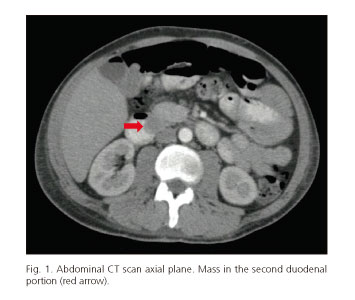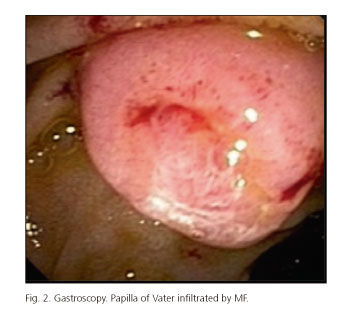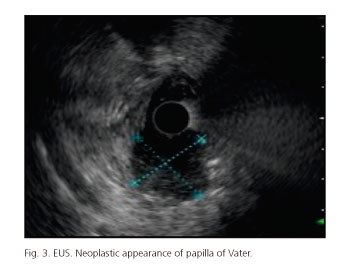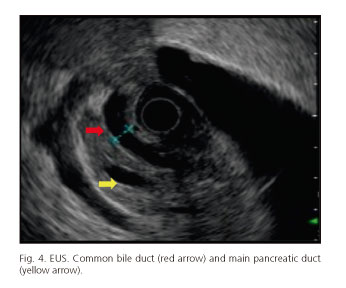My SciELO
Services on Demand
Journal
Article
Indicators
-
 Cited by SciELO
Cited by SciELO -
 Access statistics
Access statistics
Related links
-
 Cited by Google
Cited by Google -
 Similars in
SciELO
Similars in
SciELO -
 Similars in Google
Similars in Google
Share
Revista Española de Enfermedades Digestivas
Print version ISSN 1130-0108
Rev. esp. enferm. dig. vol.108 n.8 Madrid Aug. 2016
https://dx.doi.org/10.17235/reed.2015.3831/2015
Unusual involvement in mycosis fungoides: duodenal papilla
Compromiso inusual por micosis fungoide: papila duodenal
Álvaro Andrés Gómez-Venegas and Rómulo Darío Vargas-Rubio
Services of Gastroenterology and Digestive Endoscopy. Hospital Universitario San Ignacio. Bogotá, Colombia
ABSTRACT
Background: Mycosis fungoides (MF) is a type of T-cell lymphoma with cutaneous involvement. It is a rare disease, of low incidence and usually affects middle-aged men. In most cases only the skin is involved although in advanced stages may present with extra cutaneous involvement including the gastrointestinal tract.
Case report: We report the first case of MF with compromise of duodenal papilla, emphasizing the diagnostic approach and a brief review of the subject.
Discussion: This case report proves the value of the endoscopic studies in patients with lymphoproliferative disorders, because of the impact in the diagnosis and prognosis. Also, this case report is relevant because there is no scientific evidence, as far as we know, of similar cases reported.
Key words: Mycosis fungoides. Lymphoma. T-cell. Cutaneous. Papilla of Vater.
RESUMEN
Introducción: la micosis fungoide (MF) es un tipo de linfoma de células T con compromiso cutáneo. Es una enfermedad rara, de baja incidencia que se presenta usualmente en hombres de mediana edad. En la mayoría de casos el compromiso es únicamente cutáneo aunque en fases avanzadas se puede presentar compromiso extra cutáneo que incluye el tracto gastrointestinal.
Caso clínico: presentamos el primer caso reportado de MF con compromiso de la papila duodenal, su abordaje diagnóstico y una breve revisión del tema.
Discusión: este es un caso más que confirma la importancia de los estudios endoscópicos en los pacientes con neoplasias linfoproliferativas, y siempre y cuando los beneficios superen los riesgos, estos deberán realizarse, dado que pueden impactar tanto en el diagnóstico como en el pronóstico de estos pacientes. Este caso, además, es relevante ya que no hay evidencia científica de casos similares reportados en la literatura.
Palabras clave: Micosis fungoide. Linfoma. Linfocito T. Cutáneo. Ampolla de Vater.
Introduction
Mycosis fungoides (MF) is a type of T-cell lymphoma with cutaneous involvement (1). It is a rare disease, of low incidence, and usually affects middle-aged men (2). In most cases, only the skin is involved (3), although in advanced stages it may present with extracutaneous involvement, including the gastrointestinal tract (4,5). We report the first case of MF involving the duodenal papilla, emphasizing the diagnostic approach and a brief review of the subject.
Case Report
This is a 45-years-old man who was diagnosed with cutaneous T lymphoma five years ago and was treated with several lines of chemotherapy, from methotrexate to liposomal doxorubicin. He entered through the emergency room of our hospital complaining of fever, fatigue, weakness for a week and purulent cutaneous lesions in the scalp and eyelids. At physical examination, he presented tachycardia, tachypnea, fever and more than 70% of his body surface was affected by extensive coalescent plaques, nodules and tumors, giving erythrodermic appearance, most with necrotic center and ulcerated. On his scalp there were areas of extensive ulcers draining pus. He received the diagnosis of infected skin lesions by MF and blepharoconjunctivitis. He was treated with broad-spectrum antibiotics but patient's clinical course was torpid, with persistent signs of systemic inflammatory response, thus requiring carbapenem and oxazolidone. Fever persisted after 14 days of antibiotic treatment. A computed tomography (CT) of the chest and abdomen was performed in search of other sites of infection and as staging of the MF, besides bone marrow biopsy. On CT, some pathological cervical and inguinal lymph nodes were observed and at the level of the second portion of the duodenum there was a mass associated to pneumobilia and a dilated common bile duct (Fig. 1). A duodenoscopy showed a large duodenal papilla, its mucosal surface appearing infiltrated, eroded, friable, easily bleeding. Multiple biopsies were taken (Fig. 2). A fistulous suprapapillary orifice draining bile was also observed. An endoscopic ultrasound (EUS) showed duodenal papilla infiltrated by a hypoechoic lesion of 26 mm x 24 mm in diameter, heterogeneous, ill-defined borders, with secondary infiltration of the pancreatic head without vascular invasion or regional lymph nodes. The bile duct and main pancreatic duct were dilated with diameters of 8 and 5 mm respectively (Figs. 3 and 4). Histopathology showed duodenal mucosa infiltrated by atypical lymphoid cells. Immunohistochemistry revealed dense infiltration of T cells positive for CD3 and CD5, CD7 focal loss of dominance and CD4 cell proliferation rate of 15% plus few CD20 positive B cells intermingled, suggestive of infiltration by MF. Bone marrow biopsy confirmed the same findings.
Considering the extensive commitment to MF, the refractory to several lines of oncological management and the difficulty in controlling the infectious process, no salvage chemotherapy began. Finally, after 20 days of hospitalization the patient died of septic shock and severe sepsis.
Discussion
MF is the most common cutaneous T-cell lymphoma (1). The MF incidence is about 3 per million a year, affecting people between 55 to 60 years of age (2). The disease may have a slow, indolent evolution and causes skin lesions that include nodules, plaques, and tumors that can progress to compromise an extensive area of skin (3). In advanced cases with aggressive disease, it may be seen compromise of bone marrow, lymph nodes, liver, lung and gastrointestinal tract. Some autopsy studies have shown that between 70% and 90% of patients die of visceral MF involvement. Visceral involvement correlates to the severity of skin lesions, and cutaneous infections are common (4,5). It is recommended to confirm visceral involvement with biopsies and immunohistochemically because non-lymphomatous tumors can occur in long term affected patients of less than 30 years of age. A retrospective study of 404 patients found a high risk of primary non-skin neoplasia in MF patients (SIR 3.40; 95% CI, 1.55-6.45), mostly synchronic lymphoma (SIR 12.86; 95% CI, 2.65-37.59) and melanoma (SIR 9.31; 95% CI, 8.75-33.62) (6). Colorectal, liver, biliary tract, lung and urinary tumors have been also reported (7). MF patients' survival depends on disease stage. In early stages it equals general population survival, but in extracutaneous involvement it can be as short as 1 to 2 years. Dismal prognosis factors also include older patients, refractoriness to successive treatment protocols, lymph node involvement and presence of Sézary cells in histology (7,8).
MF gastrointestinal involvement can be primary or spreading from cutaneous disease. Primary forms are quite rare and patients can present diarrhea, perforation, bleeding, dysphagia and intestinal obstruction (9-12). In cases of cutaneous spreading to digestive tract, involvement often occurs in the stomach, small bowel and pancreas (13-15). Arai et al. (13) reported an autopsy study of 107 patients and found pancreas involvement in 20% of cases. Madsen et al. (14) reported a 39 year old patient with refractory MF that presented biliary obstruction due to MF involvement of biliary tract. Gottlieb et al. (15) also reported a patient with biliary MF obstruction due to a pancreatic MF. On EUS they found a hypoechoic infiltrative lesion in the head of the pancreas, without vascular and lymph node involvement. Fine needle biopsy of the lesion shows lymphoma cells, CD45, CD3 positives, CD5, CD20, SYP, cytokeratines and chromogranin negatives, suggesting T-cell MF lymphoma.
We here report an MF patient with extensive and severe cutaneous disease, with papilla of Vater involvement, with secondary biliary tract dilation; however, it never presented jaundice or liver profile alterations, due to the presence of a suprapapillary fistulae. In this patient the diagnosis of MF involvement of papilla of Vater was important to establish a prognosis, supporting the decision of giving only best supportive and compassionate care in a patient refractory to second line treatment protocols. This case report proves the value of the endoscopic studies in patients with lymphoproliferative disorders, because of the impact in the diagnosis and prognosis. Also, this case report is relevant because there is no scientific evidence, as far as we know, of similar cases reported.
References
1. Willemze R, Jaffe E, Burg G, et al. WHO-EORTC classification for cutaneous lymphomas. Blood 2005;105:3768-85. DOI: 10.1182/blood-2004-09-3502. [ Links ]
2. Morales Suárez-Varela M, Llopis G, Marquina V, et al. Mycosis fungoides: review of epidemiological observations. Dermatology 2000;201:21-8. DOI: 10.1159/000018423. [ Links ]
3. Jawed S, Myskowski P, Horwitz S, et al. Primary cutaneous T-cell lymphoma (mycosis fungoides and Sézary syndrome) Part I. Diagnosis: Clinical and histopathologic features and new molecular and biologic markers. J Am Acad Dermatol 2014;70:205.e1-205.e16. DOI: 10.1016/j.jaad.2013.07.049. [ Links ]
4. Long J, Mihm M. Mycosis fungoides with extracutaneous dissemination: A distinct clinicopathologic entity. Cancer 1974;34:1745-55. DOI: 10.1002/1097-0142(197411)34:5<1745::AID-CNCR2820340524> 3.0.CO;2-W. [ Links ]
5. Rappaport H, Thomas L. Mycosis fungoides: The pathology of extracutaneous involvement. Cancer 1974;34:1198-229. DOI: 10.1002/1097-0142(197410)34:4<1198::AID-CNCR2820340431> 3.0.CO;2-E. [ Links ]
6. Ai WZ, Keegan TH, Press DJ, et al. Outcomes after diagnosis of mycosis fungoides and Sézary syndrome before 30 years of age: A population-based study. JAMA Dermatol 2014;150:709-15. DOI: 10.1001/jamadermatol.2013.7747. [ Links ]
7. Lindahl L, Fenger-Grøn M, Iversen L. Subsequent cancers, mortality, and causes of death in patients with mycosis fungoides and parapsoriasis: A Danish nationwide, population-based cohort study. J Am Acad Dermatol 2014;71:529-35. DOI: 10.1016/j.jaad.2014.03.044. [ Links ]
8. Jawed S, Myskowski P, Horwitz S, et al. Primary cutaneous T-cell lymphoma (mycosis fungoides and Sézary syndrome) Part II. Prognosis, management, and future directions. J Am Acad Dermatol 2014;70:223.e1-223.e17. DOI: 10.1016/j.jaad.2013.08.033. [ Links ]
9. Cohen M, Widerlite L, Schechter G, et al. Gastrointestinal involvement in the Sézary syndrome. Gastroenterology 1977;73:145-9. [ Links ]
10. Camisa C, Goldstein A. Mycosis fungoides: Small-bowel involvement complicated by perforation and peritonitis. Arch Dermatol 1981;117:234-7. DOI: 10.1001/archderm.1981.01650040050021. [ Links ]
11. Redleaf M, Moran W, Gruber B. Mycosis fungoides involving the cervical esophagus. Arch Otolaryngol Head Neck Surg 1993;119:690-3. DOI: 10.1001/archotol.1993.01880180110022. [ Links ]
12. Ellis R, Smith C, Goodlad N, et al. Mesenteric vasculitis associated with Sézary syndrome. Gut 1996; 39: 334-5. DOI: 10.1136/gut.39.2.334. [ Links ]
13. Arai E, Katayama I, Ishihara K. Mycosis fungoides and Sézary syndrome in Japan. Clinicopathologic study of 107 autopsy cases. Pathol Res Pract 1991;187:451-7. DOI: 10.1016/S0344-0338(11)80006-3. [ Links ]
14. Madsen J, Tallini G, Glusac E, et al. Biliary tract obstruction secondary to mycosis fungoides: A case report. J Clin Gastroenterol 1999;28:56-60. DOI: 10.1097/00004836-199901000-00015. [ Links ]
15. Gottlieb K, Anders K, Kaya H. Obstructive jaundice in a patient with mycosis fungoides metastatic to the pancreas. EUS findings. JOP 2008;9:719-24. [ Links ]
![]() Correspondence:
Correspondence:
Álvaro Andrés Gómez-Venegas.
Services of Gastroenterology and Digestive Endoscopy.
Hospital Universitario San Ignacio.
Bogotá, Colombia
e-mail: aagvab@hotmail.com
Received: 30/04/2015
Accepted: 31/05/2015











 text in
text in 





